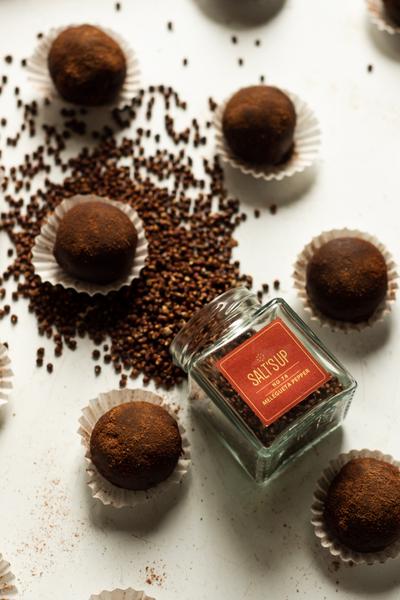What is Melegueta Pepper also known as grains of paradise?
Grains of paradise, Melegueta Pepper is an herbaceous perennial plant native to Western Africa. The Latin name is Aframomum melegueta and it is a member of the ginger family. The spice is known by many other names including grains of paradise, ossame, alligator pepper, African pepper, Guinea grains, and Guinea pepper. The people of Ghana call this spice hentai.
- Grains of Paradise Spice Taste Profile
- Melegueta Pepper vs Black Pepper
- How to Store Grains of Paradise
- Find out More About Melegueta Pepper
- What is Melegueta Pepper Used For?
- Historical Background of African Pepper
- How is Aframomum Melegueta Grown and Harvested?
- Cooking with Grains of Paradise, Melegueta pepper. Grains of paradise taste.
- Spicing Beverages Just Right with grains of paradise.
- Aframomum, paradise pepper benefits
- Guinea Pepper Voodoo
- Why We Love grains of paradise, Melegueta pepper

Grains of Paradise Spice Taste Profile
Grains of paradise have a peppery warmth. Then, the citrus notes meet, with a hint of cinnamon, clove, and cardamom. The aroma is reminiscent of walking through a pine tree-filled forest.
Melegueta Pepper vs Black Pepper
Unlike black pepper, alligator pepper is a dried seed and not a berry. Perkins is a naturally occurring organic compound that is prevalent in black pepper. The alkaloid it contains, known as piperine, is what gives black pepper its peppery taste. Peperine is absent in the genetic makeup of melegueta pepper.
Alligator pepper sounds like spice with some bite to it. Yet, the truth is it is rather mild, in comparison to black pepper. What the seed does contain is a combination of unique, aromatic ketones that lends their own unique peppery taste. A dominating flavor that comes from essential oils in the spice cardamom is also found in trace quantities in melegueta pepper. Hence, the slight cardamom flavor, as an endnote flavor.
How to Store Grains of Paradise
Store the whole seeds in a glass jar, with a tight-fitting lid, like the jars this spice is sold in at Salt’s Up. Keep in a cool, dry, dark cupboard for up to three years.
Once crushed, it can be added to many cuisines. We suggest using the crushed spice immediately when the taste and fragrance are at their finest.
Find out More About Melegueta Pepper
Today, due to its small production, grains of paradise is a premium spice. It is finding its way into professional chef kitchens and the homes of gourmet enthusiasts.
Find out more about melegueta pepper. From its colorful history to its many uses in both the savory and the sweet side of the kitchen, this little seed tells a fascinating story. Read on!

What is Melegueta Pepper Used For?
The seeds of the Aframomum melegueta can be used whole or crushed, and either during the cooking preparation or as a final seasoning in place of black pepper. It is a spice that blends well with others particularly, thyme, rosemary, and sage.
To crush melegueta pepper, it is best to use a mortar and pestle, as the seeds are hard. Once crushed, the seeds release the full flavor and a white-colored interior.
Recipes generally require a ¼ teaspoon to 1 teaspoon for cooking. In baking, it is suggested that the spice be ground further down into a powder before incorporating it into cookies, cakes, or bread.
The spice was often mixed in a blend named galot daggo. This was made with peppercorns, cinnamon, cloves, and nutmeg. Often cubeb pepper would be substituted for nutmeg.
Historical Background of African Pepper
Arab, Berber, and Jewish traders were the first to sing the praises of the African pepper. From West Africa, in what today is Liberia, camel caravans would slowly navigate across the Sahel, through the endless Sahara, and then across Sudan. Eventually, the spices would make the ocean voyage into Europe.
At first, the spice was simply identified and named African pepper. Pliny the Elder, a 1st-century military commander, and writer, who was most lauded for his encyclopedic Natural History book, makes note of the African pepper in his writings.
Later, the spice was renamed, by the Europeans, as grains of paradise. This created a distinction between the melegueta pepper and black pepper, the latter of which was sold at a premium price. Lighter on the coin purse, it is not surprising that grains of paradise became a popular substitute for black pepper, in European kitchens in the 14th and 15th centuries.
During this period, spices, in general, were used not only in cooking but for the keeping quality of food and beverages. The Ménagier de Parisor Parisian Household Book, of 1393, advised using grains of paradise to improve wine that had gone stale.
In the mid-1400s, King Afonso V of Portugal, gave exclusive trading access to Fernão Gomes, a merchant from Lisbon, to 100 miles of the Gulf of Guinea, in West Africa. This gave the savvy business owner dominance over the now-beloved Aframomum melegueta. He achieved this coup, by paying the King 1000,000 real, annually for five years.
By then, the grains of paradise spice were renamed melegueta pepper. What does melegueta mean? Historians say the term could be related to the Italian word for millet, which is meligo. Others claim it takes its name from the Spanish town of Málaga, then an ancient Phoenician port. Regardless, the French translated this word into maniguette.
Guinea grains, Guinea pepper, and alligator spice are other names given to this spice by the British.
How is Aframomum Melegueta Grown and Harvested?
The Aframomum melegueta perennial plant, while short in stature and size, at only 35 centimeters in length and 15 in width, becomes a riot of purple flowers, when in bloom. Each trumpet-shaped blossom announces its beauty, with a pinkish-orange blush base, and an orange-tinged lip. The fragrance is very aromatic.
From these blooms, small tubular-shaped pods grow. Each is approximately five to seven millimeters long. Here the numerous, reddish-brown golden seeds are housed.
On farms, the men pick the pods and the woman extracts the seeds manually, removing them from the pulp. This is done with gentle care, to prevent the loss of any seeds. Leaves are then set out and the seeds are spread out to dry in the sun.
Cooking with Grains of Paradise, Melegueta pepper. Grains of paradise taste.
This spice is most prevalent in West African cooking. So important is this spice to the Yoruba culture, that a newborn baby is immediately given a taste of alligator pepper the minute it is born. There it goes by the name atare.
In its whole state, the seeds can be fried, or used as a replacement for peppercorns. When crushed, try using Malaguena pepper in curries, stews, marinades, or salad dressings. It is especially delicious with braised lamb, potatoes, and eggplant.
The seeds of the grains of paradise are a wonderful addition to gingerbread cookies and cakes.
Spicing Beverages Just Right with grains of paradise.
In West African villages, these seeds are used to flavor a traditional drink made from the kola nut. Guinea berries have found their way into craft beers. Scandinavians enjoy the flavor in the infused aquavit that they drink.
For a festive holiday flair, add a few grains of paradise to red wine, along with a bit of orange juice, a cinnamon stick, cranberries, and some orange slices. Heat and enjoy a mulled wine! Or serve the German Christmas market variety called Glühwein. The translation means glow-wine, because of how it makes the drinker feel. This may be from the extra kick of rum or amaretto added.
Bombay Sapphire Gin, is a premium gin, with an aromatic taste. Made in England, this neutral grain spirit, infused with 10 botanicals, is concocted from a recipe that dates to 1761. West African grains of paradise spice help to infuse the Bombay Sapphire bottle with flavor.
It is funny to recall that only 150 years ago, adding seeds from the grains of paradise plant to alcohol was strictly prohibited and a punishable offense. Then, it was thought to poison the body and spirit, thereby causing madness.
Bombay Sapphire Gin also contains, juniper berries, orris root, Spanish almonds, lemon peels, licorice, cassia bark, coriander, and another one of our favorite spices, cubeb berries.
Aframomum, paradise pepper benefits
In West African folk medicine, it is used as a digestive aid. It is also chewed whole to warm the body. Additionally, this African pepper is noted as a wound healer, when crushed and added to a poultice. Among the elders, both grains and pods are used as remedies in traditional medicine and prized for antibiotic and antibacterial properties.
With both its anti-inflammatory and analgesic properties, this little seed is noted to remove pain such as joint and rheumatoid arthritis pain, as well as stomach pain and even toothaches.
When the oils are extracted from the seed it appears to have antimicrobial properties, which can be beneficial in cleaning products, while fulfilling the need for natural products.
Guinea Pepper Voodoo
In the Caribbean and Latin American countries, this Guinea pepper is used in religious voodoo ceremonies. It has been said that Guinea pepper sprinkled in the bed of lovers will cause the couple to break up for good. Yet, when sprinkled around a home or yard it is said to protect the homeowner and family from allowing enemies to enter.
Why We Love grains of paradise, Melegueta pepper
We could love grains of paradise for the name alone, but we are enticed by this spice for its versatility and its exciting flavor. Try it for yourself!

